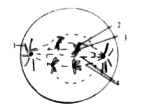Name the type of single pulley that can act as a force multiplier. Draw a labelled diagram of the above named pulley.
Step-by-Step Solution
1. Identify the Type of Pulley: The type of single pulley that acts as a force multiplier is called a single movable pulley.
2. Understanding the Mechanism: A movable pulley allows the load to be lifted with less effort compared to the weight of the load itself. This is because the pulley moves along with the load, effectively distributing the force needed to lift the load.
3. Draw the Diagram:
- Start by drawing a circle to represent the pulley.
- Draw a vertical line from the center of the pulley downwards to represent the load (L).
- Draw a vertical line upwards from the center of the pulley to represent the effort (E).
- Indicate the tension in the string (T) on both sides of the pulley, which is equal to the effort (E).
4. Label the Diagram:
- Label the load (L) acting downwards.
- Label the effort (E) acting upwards.
- Label the pulley as "Movable Pulley".
- Indicate that the tension (T) in the string is equal to the effort (E).
5. Explain the Force Multiplication:
- In a single movable pulley, the tension in the string (T) is equal to the effort (E) applied.
- Since there are two segments of the string supporting the load (one on each side of the pulley), the total upward force is 2T.
- Therefore, 2T can balance the load (L), allowing a smaller effort (E) to lift a larger load (L).
Labeled Diagram
E↑⏐⏐||−−−−−||∣∣∣∣←Movab≤P≤––––y∣∣∣∣−−−−−∣∣⏐⏐↓L
- Start by drawing a circle to represent the pulley.
- Draw a vertical line from the center of the pulley downwards to represent the load (L).
- Draw a vertical line upwards from the center of the pulley to represent the effort (E).
- Indicate the tension in the string (T) on both sides of the pulley, which is equal to the effort (E).
- Label the load (L) acting downwards.
- Label the effort (E) acting upwards.
- Label the pulley as "Movable Pulley".
- Indicate that the tension (T) in the string is equal to the effort (E).
- In a single movable pulley, the tension in the string (T) is equal to the effort (E) applied.
- Since there are two segments of the string supporting the load (one on each side of the pulley), the total upward force is 2T.
- Therefore, 2T can balance the load (L), allowing a smaller effort (E) to lift a larger load (L).
E↑⏐⏐||−−−−−||∣∣∣∣←Movab≤P≤––––y∣∣∣∣−−−−−∣∣⏐⏐↓L
Topper's Solved these Questions
Similar Questions
Name the type of a single pulley that has an ideal mechanical advantage equal to 2. draw a labelled diagram of the pulley mentioned by you.
View SolutionName the type of single pulley that has a mechanical advantage greater than one?
View SolutionName the device you will use to obtain 220 V a.c. from 11 V a.c. Draw a labelled diagram of the device. Name one type of loss of energy in it and state how is it remedied.
View SolutionName the structure in leaves through which gaseous exchange takes place. Draw a labelled diagram of it.
View SolutionWrite names of few thallophytes. Draw a well labelled diagram of Spirogyra.
View SolutionName the type of respiration labeled x in the given diagram

View SolutionA block and tackle system of pulleys has velocity ratio 4.
Draw a neat labelled diagram of the system indicating clearly the points of application and direction of load and effort.
View SolutionGiven diagram representing a stage during mitotic cell division in an animal cell:

Name the stage that comes just after the stage shown in the diagram. Draw a well labelled diagram of this stage.
View SolutionIn which direction does the force need to be applied, when a single pulley is used with a mechanical advantage greater than 1 ? How can you change the direction of force applied without altering its mechanical advantage ? Draw a labelled diagram of the system.
View SolutionWhen does a machine act as (a) a force multiplier, (b) a speed multiplier. Can a machine act as a force multiplier and a speed multiplier simultaneously ?
View Solution
